Analysis of the Darfur Conflict in International Development Studies
VerifiedAdded on 2020/05/03
|11
|2396
|58
Literature Review
AI Summary
This literature review analyzes the Darfur conflict in Sudan, which began in 2003, focusing on the causes, international responses, and the impact of the conflict. The review examines the roles of various actors, including rebel groups, the Sudanese government, and international organizations. It explores the complex interplay of political, ethnic, and religious factors that fueled the conflict, including the government's authoritarian approach and ethnic cleansing. The review also discusses the international community's response, including peacekeeping missions, the International Court of Justice's involvement, and the challenges of humanitarian intervention. The analysis highlights the limitations of international responses and the ongoing challenges in addressing the conflict, emphasizing the need for a more comprehensive approach to protect civilians and promote peace. Various scholarly perspectives are considered, including those of Williams, Bassil, Hastrup, Budabin, Selby, De Juan, Cunningham, and Ali, to provide a multifaceted understanding of the conflict's complexities and implications.
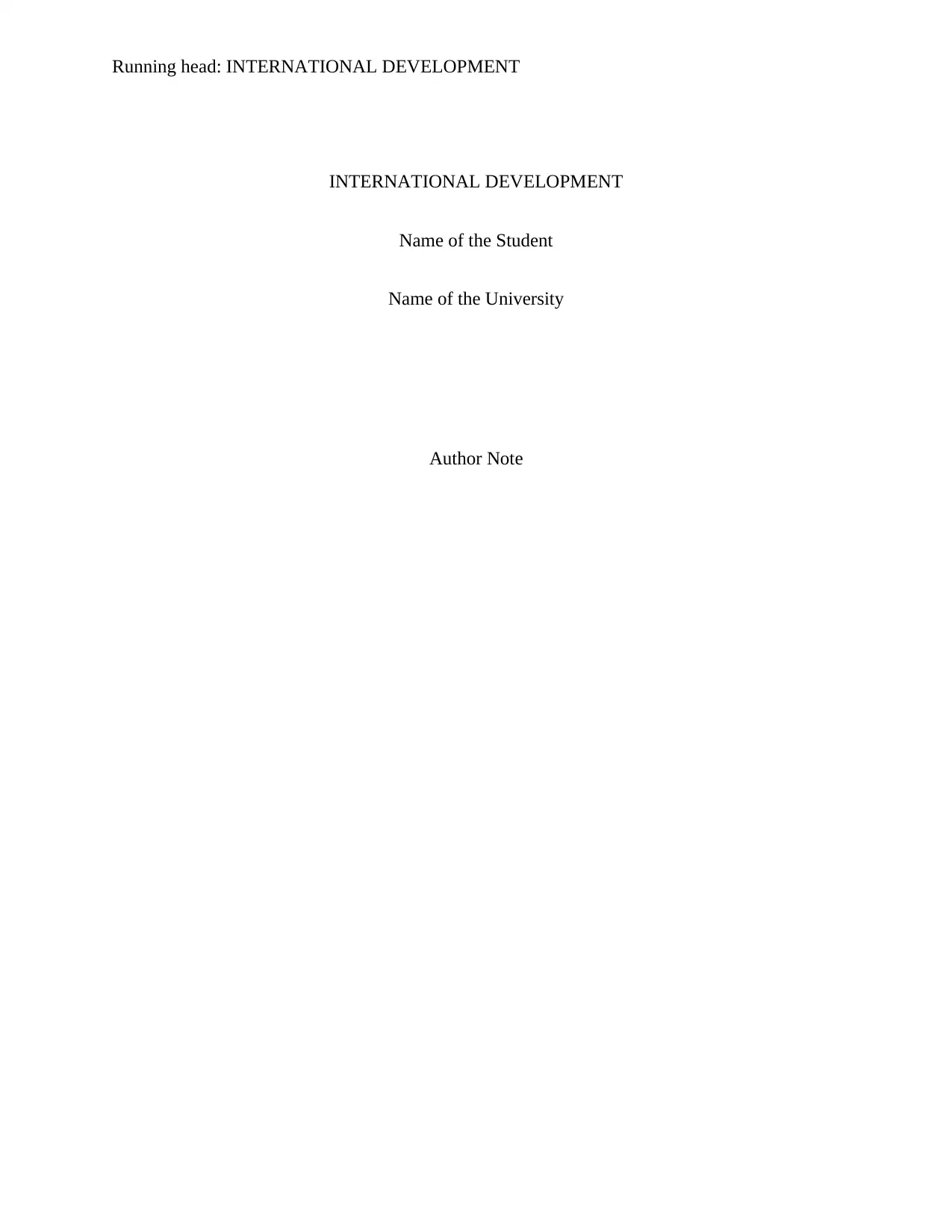
Running head: INTERNATIONAL DEVELOPMENT
INTERNATIONAL DEVELOPMENT
Name of the Student
Name of the University
Author Note
INTERNATIONAL DEVELOPMENT
Name of the Student
Name of the University
Author Note
Paraphrase This Document
Need a fresh take? Get an instant paraphrase of this document with our AI Paraphraser
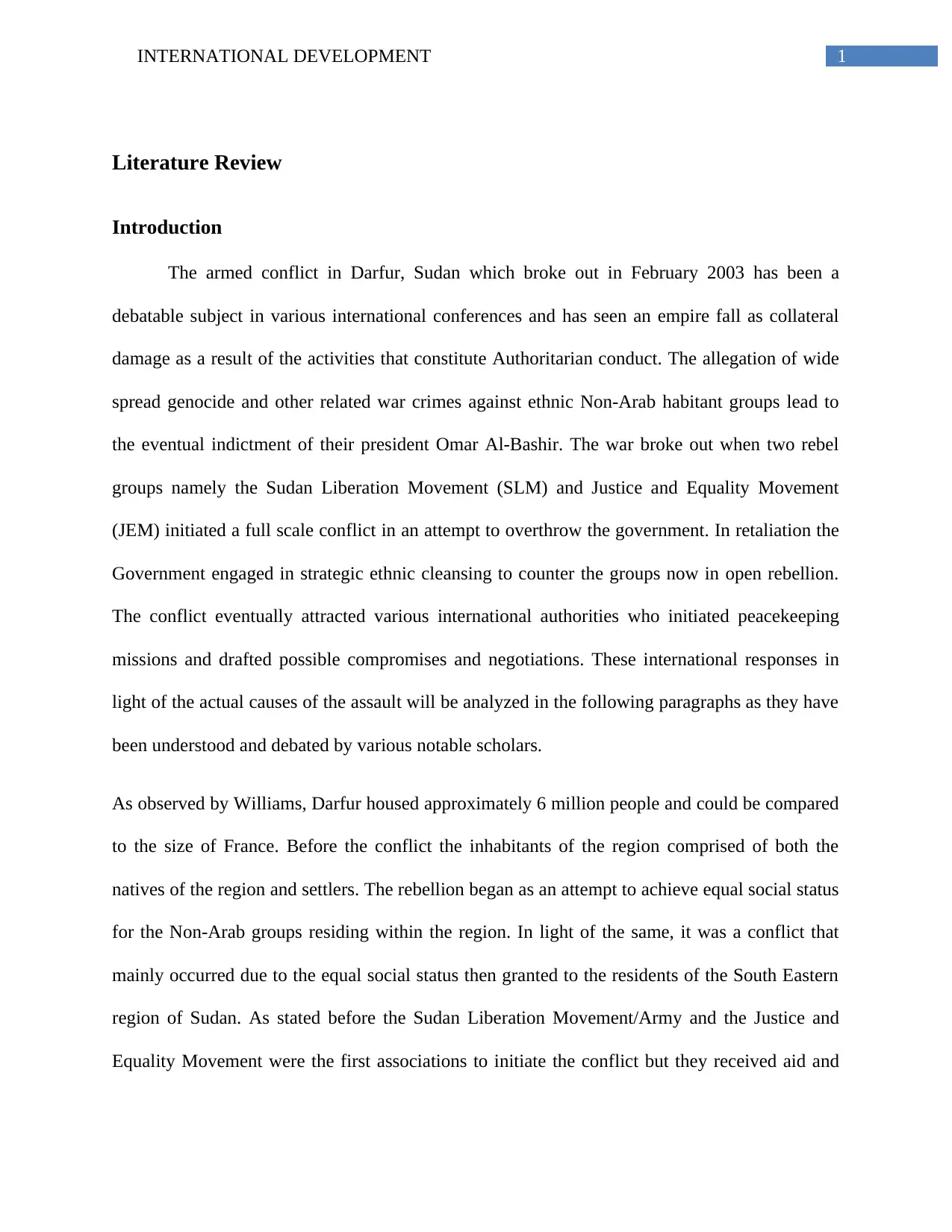
1INTERNATIONAL DEVELOPMENT
Literature Review
Introduction
The armed conflict in Darfur, Sudan which broke out in February 2003 has been a
debatable subject in various international conferences and has seen an empire fall as collateral
damage as a result of the activities that constitute Authoritarian conduct. The allegation of wide
spread genocide and other related war crimes against ethnic Non-Arab habitant groups lead to
the eventual indictment of their president Omar Al-Bashir. The war broke out when two rebel
groups namely the Sudan Liberation Movement (SLM) and Justice and Equality Movement
(JEM) initiated a full scale conflict in an attempt to overthrow the government. In retaliation the
Government engaged in strategic ethnic cleansing to counter the groups now in open rebellion.
The conflict eventually attracted various international authorities who initiated peacekeeping
missions and drafted possible compromises and negotiations. These international responses in
light of the actual causes of the assault will be analyzed in the following paragraphs as they have
been understood and debated by various notable scholars.
As observed by Williams, Darfur housed approximately 6 million people and could be compared
to the size of France. Before the conflict the inhabitants of the region comprised of both the
natives of the region and settlers. The rebellion began as an attempt to achieve equal social status
for the Non-Arab groups residing within the region. In light of the same, it was a conflict that
mainly occurred due to the equal social status then granted to the residents of the South Eastern
region of Sudan. As stated before the Sudan Liberation Movement/Army and the Justice and
Equality Movement were the first associations to initiate the conflict but they received aid and
Literature Review
Introduction
The armed conflict in Darfur, Sudan which broke out in February 2003 has been a
debatable subject in various international conferences and has seen an empire fall as collateral
damage as a result of the activities that constitute Authoritarian conduct. The allegation of wide
spread genocide and other related war crimes against ethnic Non-Arab habitant groups lead to
the eventual indictment of their president Omar Al-Bashir. The war broke out when two rebel
groups namely the Sudan Liberation Movement (SLM) and Justice and Equality Movement
(JEM) initiated a full scale conflict in an attempt to overthrow the government. In retaliation the
Government engaged in strategic ethnic cleansing to counter the groups now in open rebellion.
The conflict eventually attracted various international authorities who initiated peacekeeping
missions and drafted possible compromises and negotiations. These international responses in
light of the actual causes of the assault will be analyzed in the following paragraphs as they have
been understood and debated by various notable scholars.
As observed by Williams, Darfur housed approximately 6 million people and could be compared
to the size of France. Before the conflict the inhabitants of the region comprised of both the
natives of the region and settlers. The rebellion began as an attempt to achieve equal social status
for the Non-Arab groups residing within the region. In light of the same, it was a conflict that
mainly occurred due to the equal social status then granted to the residents of the South Eastern
region of Sudan. As stated before the Sudan Liberation Movement/Army and the Justice and
Equality Movement were the first associations to initiate the conflict but they received aid and
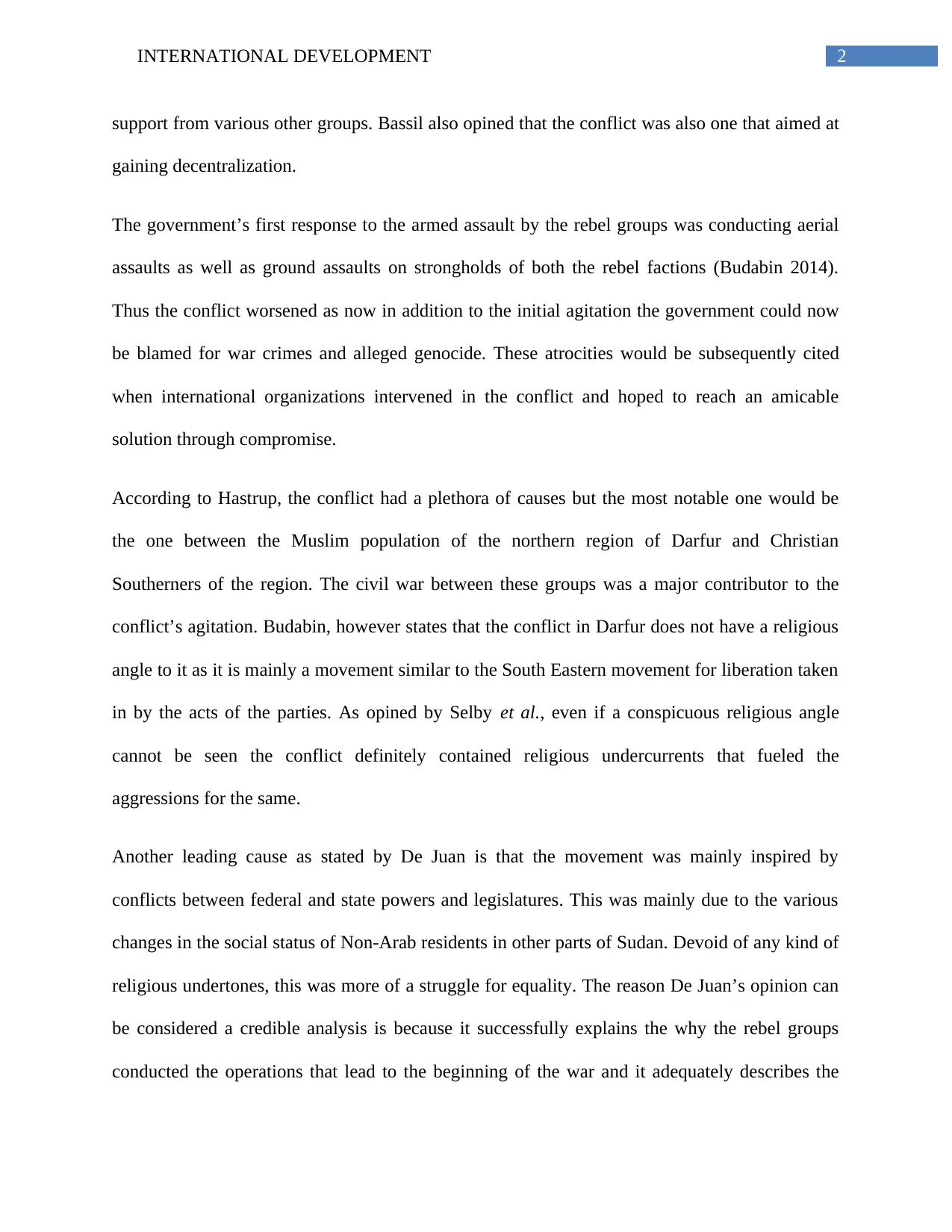
2INTERNATIONAL DEVELOPMENT
support from various other groups. Bassil also opined that the conflict was also one that aimed at
gaining decentralization.
The government’s first response to the armed assault by the rebel groups was conducting aerial
assaults as well as ground assaults on strongholds of both the rebel factions (Budabin 2014).
Thus the conflict worsened as now in addition to the initial agitation the government could now
be blamed for war crimes and alleged genocide. These atrocities would be subsequently cited
when international organizations intervened in the conflict and hoped to reach an amicable
solution through compromise.
According to Hastrup, the conflict had a plethora of causes but the most notable one would be
the one between the Muslim population of the northern region of Darfur and Christian
Southerners of the region. The civil war between these groups was a major contributor to the
conflict’s agitation. Budabin, however states that the conflict in Darfur does not have a religious
angle to it as it is mainly a movement similar to the South Eastern movement for liberation taken
in by the acts of the parties. As opined by Selby et al., even if a conspicuous religious angle
cannot be seen the conflict definitely contained religious undercurrents that fueled the
aggressions for the same.
Another leading cause as stated by De Juan is that the movement was mainly inspired by
conflicts between federal and state powers and legislatures. This was mainly due to the various
changes in the social status of Non-Arab residents in other parts of Sudan. Devoid of any kind of
religious undertones, this was more of a struggle for equality. The reason De Juan’s opinion can
be considered a credible analysis is because it successfully explains the why the rebel groups
conducted the operations that lead to the beginning of the war and it adequately describes the
support from various other groups. Bassil also opined that the conflict was also one that aimed at
gaining decentralization.
The government’s first response to the armed assault by the rebel groups was conducting aerial
assaults as well as ground assaults on strongholds of both the rebel factions (Budabin 2014).
Thus the conflict worsened as now in addition to the initial agitation the government could now
be blamed for war crimes and alleged genocide. These atrocities would be subsequently cited
when international organizations intervened in the conflict and hoped to reach an amicable
solution through compromise.
According to Hastrup, the conflict had a plethora of causes but the most notable one would be
the one between the Muslim population of the northern region of Darfur and Christian
Southerners of the region. The civil war between these groups was a major contributor to the
conflict’s agitation. Budabin, however states that the conflict in Darfur does not have a religious
angle to it as it is mainly a movement similar to the South Eastern movement for liberation taken
in by the acts of the parties. As opined by Selby et al., even if a conspicuous religious angle
cannot be seen the conflict definitely contained religious undercurrents that fueled the
aggressions for the same.
Another leading cause as stated by De Juan is that the movement was mainly inspired by
conflicts between federal and state powers and legislatures. This was mainly due to the various
changes in the social status of Non-Arab residents in other parts of Sudan. Devoid of any kind of
religious undertones, this was more of a struggle for equality. The reason De Juan’s opinion can
be considered a credible analysis is because it successfully explains the why the rebel groups
conducted the operations that lead to the beginning of the war and it adequately describes the
⊘ This is a preview!⊘
Do you want full access?
Subscribe today to unlock all pages.

Trusted by 1+ million students worldwide
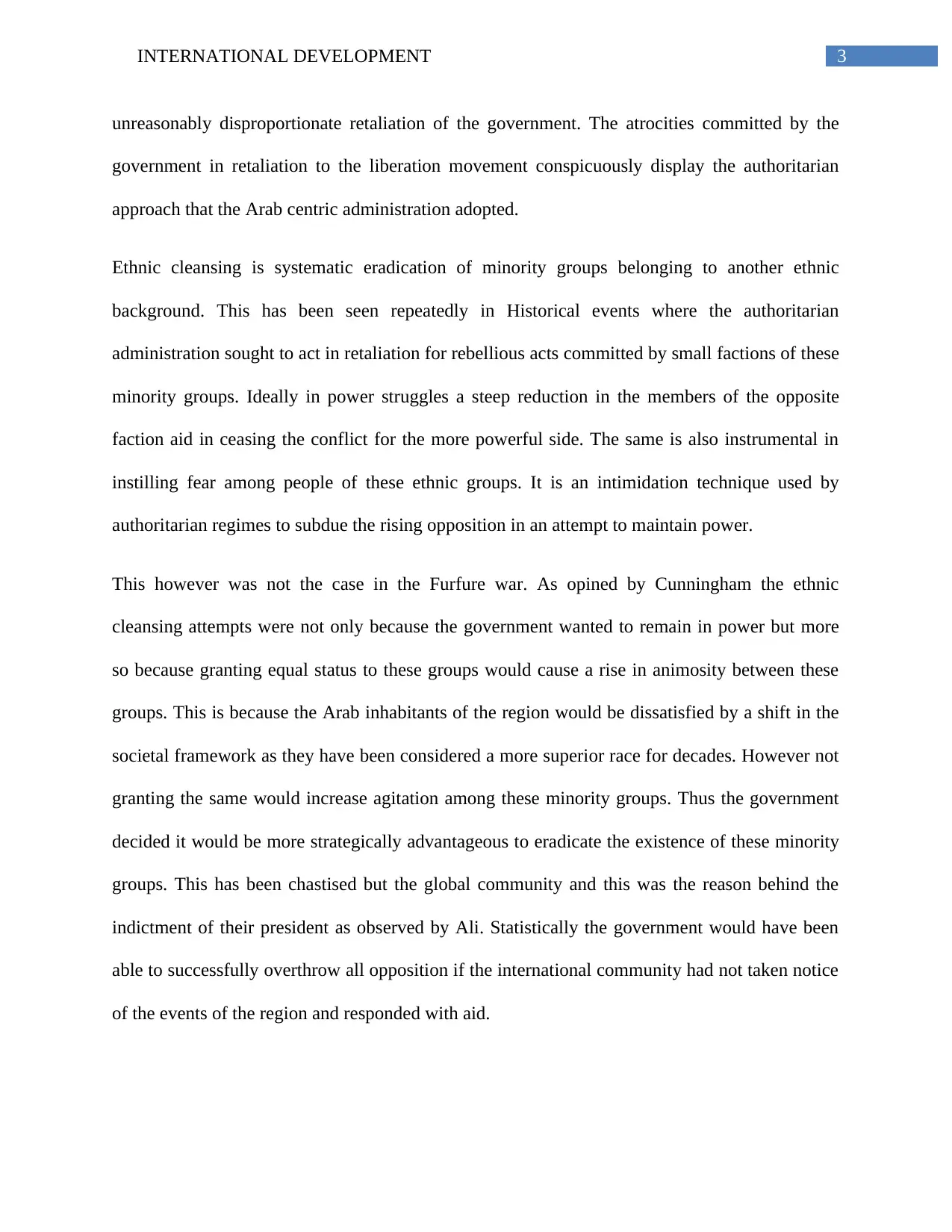
3INTERNATIONAL DEVELOPMENT
unreasonably disproportionate retaliation of the government. The atrocities committed by the
government in retaliation to the liberation movement conspicuously display the authoritarian
approach that the Arab centric administration adopted.
Ethnic cleansing is systematic eradication of minority groups belonging to another ethnic
background. This has been seen repeatedly in Historical events where the authoritarian
administration sought to act in retaliation for rebellious acts committed by small factions of these
minority groups. Ideally in power struggles a steep reduction in the members of the opposite
faction aid in ceasing the conflict for the more powerful side. The same is also instrumental in
instilling fear among people of these ethnic groups. It is an intimidation technique used by
authoritarian regimes to subdue the rising opposition in an attempt to maintain power.
This however was not the case in the Furfure war. As opined by Cunningham the ethnic
cleansing attempts were not only because the government wanted to remain in power but more
so because granting equal status to these groups would cause a rise in animosity between these
groups. This is because the Arab inhabitants of the region would be dissatisfied by a shift in the
societal framework as they have been considered a more superior race for decades. However not
granting the same would increase agitation among these minority groups. Thus the government
decided it would be more strategically advantageous to eradicate the existence of these minority
groups. This has been chastised but the global community and this was the reason behind the
indictment of their president as observed by Ali. Statistically the government would have been
able to successfully overthrow all opposition if the international community had not taken notice
of the events of the region and responded with aid.
unreasonably disproportionate retaliation of the government. The atrocities committed by the
government in retaliation to the liberation movement conspicuously display the authoritarian
approach that the Arab centric administration adopted.
Ethnic cleansing is systematic eradication of minority groups belonging to another ethnic
background. This has been seen repeatedly in Historical events where the authoritarian
administration sought to act in retaliation for rebellious acts committed by small factions of these
minority groups. Ideally in power struggles a steep reduction in the members of the opposite
faction aid in ceasing the conflict for the more powerful side. The same is also instrumental in
instilling fear among people of these ethnic groups. It is an intimidation technique used by
authoritarian regimes to subdue the rising opposition in an attempt to maintain power.
This however was not the case in the Furfure war. As opined by Cunningham the ethnic
cleansing attempts were not only because the government wanted to remain in power but more
so because granting equal status to these groups would cause a rise in animosity between these
groups. This is because the Arab inhabitants of the region would be dissatisfied by a shift in the
societal framework as they have been considered a more superior race for decades. However not
granting the same would increase agitation among these minority groups. Thus the government
decided it would be more strategically advantageous to eradicate the existence of these minority
groups. This has been chastised but the global community and this was the reason behind the
indictment of their president as observed by Ali. Statistically the government would have been
able to successfully overthrow all opposition if the international community had not taken notice
of the events of the region and responded with aid.
Paraphrase This Document
Need a fresh take? Get an instant paraphrase of this document with our AI Paraphraser
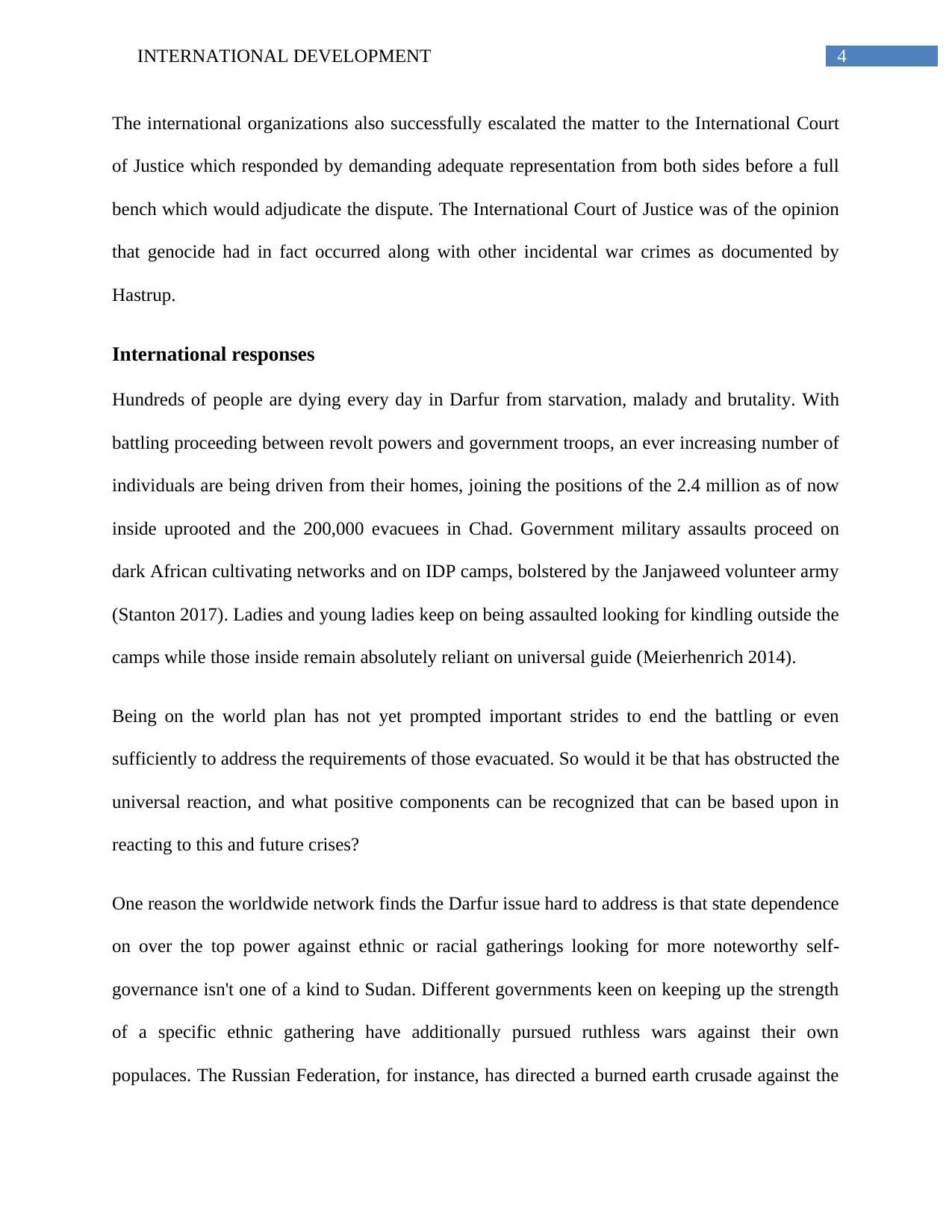
4INTERNATIONAL DEVELOPMENT
The international organizations also successfully escalated the matter to the International Court
of Justice which responded by demanding adequate representation from both sides before a full
bench which would adjudicate the dispute. The International Court of Justice was of the opinion
that genocide had in fact occurred along with other incidental war crimes as documented by
Hastrup.
International responses
Hundreds of people are dying every day in Darfur from starvation, malady and brutality. With
battling proceeding between revolt powers and government troops, an ever increasing number of
individuals are being driven from their homes, joining the positions of the 2.4 million as of now
inside uprooted and the 200,000 evacuees in Chad. Government military assaults proceed on
dark African cultivating networks and on IDP camps, bolstered by the Janjaweed volunteer army
(Stanton 2017). Ladies and young ladies keep on being assaulted looking for kindling outside the
camps while those inside remain absolutely reliant on universal guide (Meierhenrich 2014).
Being on the world plan has not yet prompted important strides to end the battling or even
sufficiently to address the requirements of those evacuated. So would it be that has obstructed the
universal reaction, and what positive components can be recognized that can be based upon in
reacting to this and future crises?
One reason the worldwide network finds the Darfur issue hard to address is that state dependence
on over the top power against ethnic or racial gatherings looking for more noteworthy self-
governance isn't one of a kind to Sudan. Different governments keen on keeping up the strength
of a specific ethnic gathering have additionally pursued ruthless wars against their own
populaces. The Russian Federation, for instance, has directed a burned earth crusade against the
The international organizations also successfully escalated the matter to the International Court
of Justice which responded by demanding adequate representation from both sides before a full
bench which would adjudicate the dispute. The International Court of Justice was of the opinion
that genocide had in fact occurred along with other incidental war crimes as documented by
Hastrup.
International responses
Hundreds of people are dying every day in Darfur from starvation, malady and brutality. With
battling proceeding between revolt powers and government troops, an ever increasing number of
individuals are being driven from their homes, joining the positions of the 2.4 million as of now
inside uprooted and the 200,000 evacuees in Chad. Government military assaults proceed on
dark African cultivating networks and on IDP camps, bolstered by the Janjaweed volunteer army
(Stanton 2017). Ladies and young ladies keep on being assaulted looking for kindling outside the
camps while those inside remain absolutely reliant on universal guide (Meierhenrich 2014).
Being on the world plan has not yet prompted important strides to end the battling or even
sufficiently to address the requirements of those evacuated. So would it be that has obstructed the
universal reaction, and what positive components can be recognized that can be based upon in
reacting to this and future crises?
One reason the worldwide network finds the Darfur issue hard to address is that state dependence
on over the top power against ethnic or racial gatherings looking for more noteworthy self-
governance isn't one of a kind to Sudan. Different governments keen on keeping up the strength
of a specific ethnic gathering have additionally pursued ruthless wars against their own
populaces. The Russian Federation, for instance, has directed a burned earth crusade against the
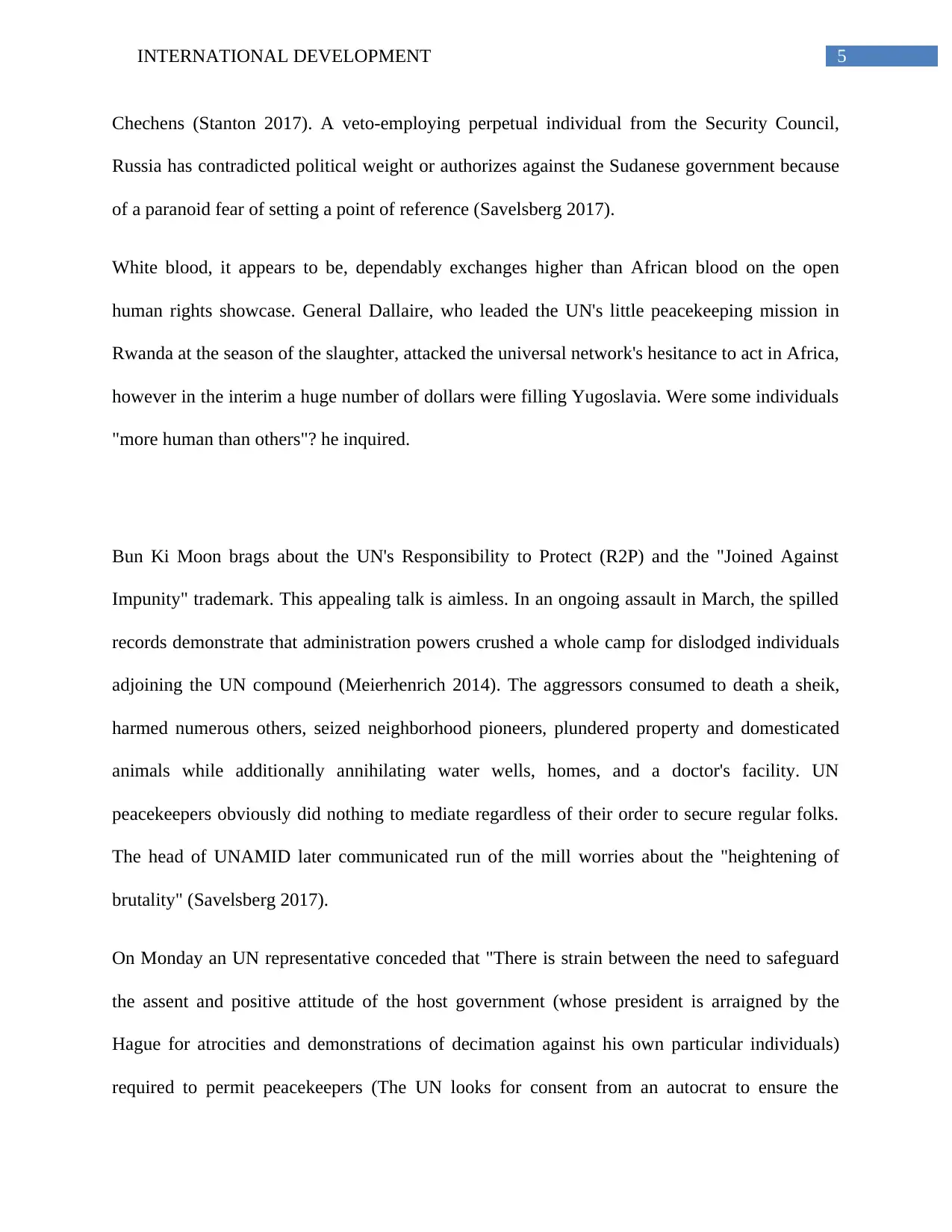
5INTERNATIONAL DEVELOPMENT
Chechens (Stanton 2017). A veto-employing perpetual individual from the Security Council,
Russia has contradicted political weight or authorizes against the Sudanese government because
of a paranoid fear of setting a point of reference (Savelsberg 2017).
White blood, it appears to be, dependably exchanges higher than African blood on the open
human rights showcase. General Dallaire, who leaded the UN's little peacekeeping mission in
Rwanda at the season of the slaughter, attacked the universal network's hesitance to act in Africa,
however in the interim a huge number of dollars were filling Yugoslavia. Were some individuals
"more human than others"? he inquired.
Bun Ki Moon brags about the UN's Responsibility to Protect (R2P) and the "Joined Against
Impunity" trademark. This appealing talk is aimless. In an ongoing assault in March, the spilled
records demonstrate that administration powers crushed a whole camp for dislodged individuals
adjoining the UN compound (Meierhenrich 2014). The aggressors consumed to death a sheik,
harmed numerous others, seized neighborhood pioneers, plundered property and domesticated
animals while additionally annihilating water wells, homes, and a doctor's facility. UN
peacekeepers obviously did nothing to mediate regardless of their order to secure regular folks.
The head of UNAMID later communicated run of the mill worries about the "heightening of
brutality" (Savelsberg 2017).
On Monday an UN representative conceded that "There is strain between the need to safeguard
the assent and positive attitude of the host government (whose president is arraigned by the
Hague for atrocities and demonstrations of decimation against his own particular individuals)
required to permit peacekeepers (The UN looks for consent from an autocrat to ensure the
Chechens (Stanton 2017). A veto-employing perpetual individual from the Security Council,
Russia has contradicted political weight or authorizes against the Sudanese government because
of a paranoid fear of setting a point of reference (Savelsberg 2017).
White blood, it appears to be, dependably exchanges higher than African blood on the open
human rights showcase. General Dallaire, who leaded the UN's little peacekeeping mission in
Rwanda at the season of the slaughter, attacked the universal network's hesitance to act in Africa,
however in the interim a huge number of dollars were filling Yugoslavia. Were some individuals
"more human than others"? he inquired.
Bun Ki Moon brags about the UN's Responsibility to Protect (R2P) and the "Joined Against
Impunity" trademark. This appealing talk is aimless. In an ongoing assault in March, the spilled
records demonstrate that administration powers crushed a whole camp for dislodged individuals
adjoining the UN compound (Meierhenrich 2014). The aggressors consumed to death a sheik,
harmed numerous others, seized neighborhood pioneers, plundered property and domesticated
animals while additionally annihilating water wells, homes, and a doctor's facility. UN
peacekeepers obviously did nothing to mediate regardless of their order to secure regular folks.
The head of UNAMID later communicated run of the mill worries about the "heightening of
brutality" (Savelsberg 2017).
On Monday an UN representative conceded that "There is strain between the need to safeguard
the assent and positive attitude of the host government (whose president is arraigned by the
Hague for atrocities and demonstrations of decimation against his own particular individuals)
required to permit peacekeepers (The UN looks for consent from an autocrat to ensure the
⊘ This is a preview!⊘
Do you want full access?
Subscribe today to unlock all pages.

Trusted by 1+ million students worldwide
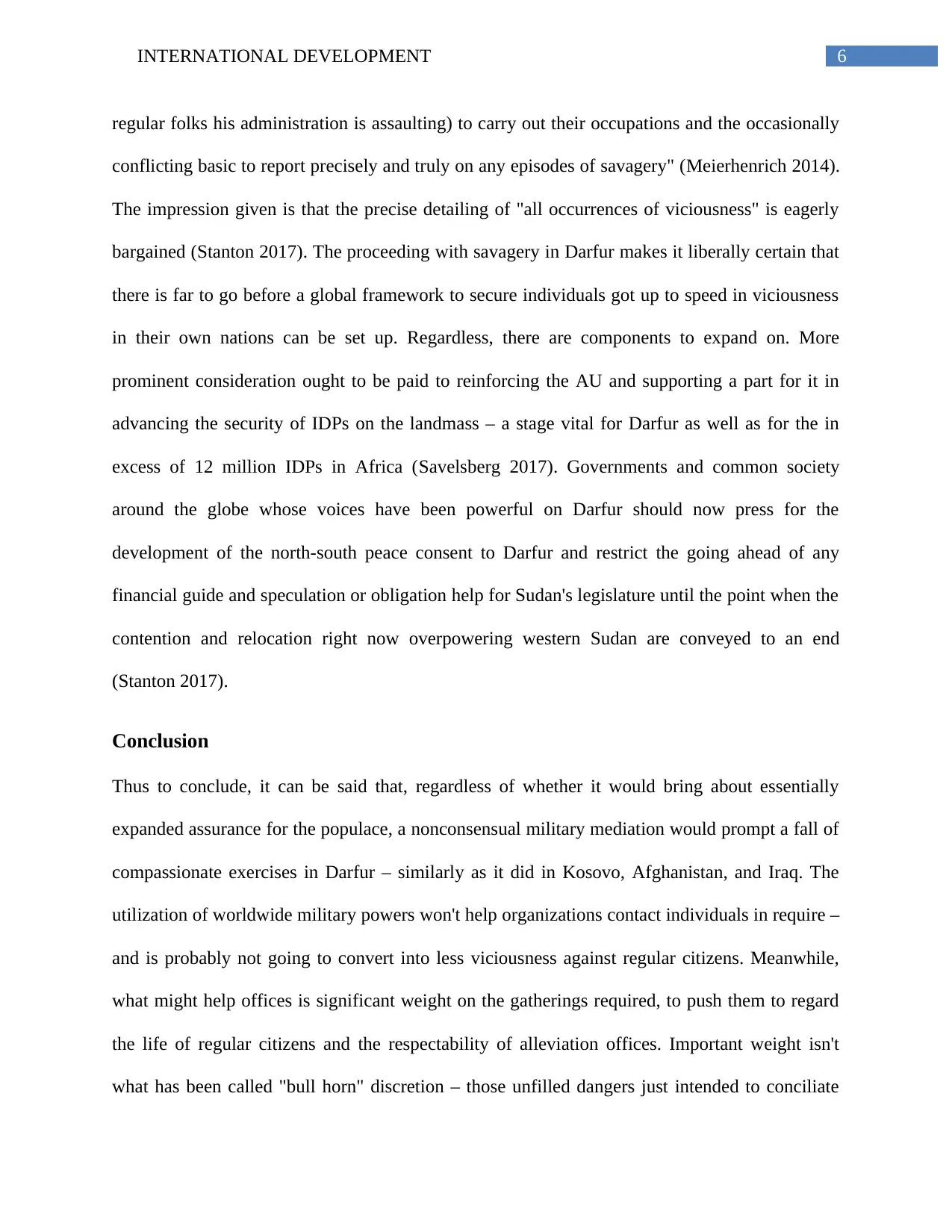
6INTERNATIONAL DEVELOPMENT
regular folks his administration is assaulting) to carry out their occupations and the occasionally
conflicting basic to report precisely and truly on any episodes of savagery" (Meierhenrich 2014).
The impression given is that the precise detailing of "all occurrences of viciousness" is eagerly
bargained (Stanton 2017). The proceeding with savagery in Darfur makes it liberally certain that
there is far to go before a global framework to secure individuals got up to speed in viciousness
in their own nations can be set up. Regardless, there are components to expand on. More
prominent consideration ought to be paid to reinforcing the AU and supporting a part for it in
advancing the security of IDPs on the landmass – a stage vital for Darfur as well as for the in
excess of 12 million IDPs in Africa (Savelsberg 2017). Governments and common society
around the globe whose voices have been powerful on Darfur should now press for the
development of the north-south peace consent to Darfur and restrict the going ahead of any
financial guide and speculation or obligation help for Sudan's legislature until the point when the
contention and relocation right now overpowering western Sudan are conveyed to an end
(Stanton 2017).
Conclusion
Thus to conclude, it can be said that, regardless of whether it would bring about essentially
expanded assurance for the populace, a nonconsensual military mediation would prompt a fall of
compassionate exercises in Darfur – similarly as it did in Kosovo, Afghanistan, and Iraq. The
utilization of worldwide military powers won't help organizations contact individuals in require –
and is probably not going to convert into less viciousness against regular citizens. Meanwhile,
what might help offices is significant weight on the gatherings required, to push them to regard
the life of regular citizens and the respectability of alleviation offices. Important weight isn't
what has been called "bull horn" discretion – those unfilled dangers just intended to conciliate
regular folks his administration is assaulting) to carry out their occupations and the occasionally
conflicting basic to report precisely and truly on any episodes of savagery" (Meierhenrich 2014).
The impression given is that the precise detailing of "all occurrences of viciousness" is eagerly
bargained (Stanton 2017). The proceeding with savagery in Darfur makes it liberally certain that
there is far to go before a global framework to secure individuals got up to speed in viciousness
in their own nations can be set up. Regardless, there are components to expand on. More
prominent consideration ought to be paid to reinforcing the AU and supporting a part for it in
advancing the security of IDPs on the landmass – a stage vital for Darfur as well as for the in
excess of 12 million IDPs in Africa (Savelsberg 2017). Governments and common society
around the globe whose voices have been powerful on Darfur should now press for the
development of the north-south peace consent to Darfur and restrict the going ahead of any
financial guide and speculation or obligation help for Sudan's legislature until the point when the
contention and relocation right now overpowering western Sudan are conveyed to an end
(Stanton 2017).
Conclusion
Thus to conclude, it can be said that, regardless of whether it would bring about essentially
expanded assurance for the populace, a nonconsensual military mediation would prompt a fall of
compassionate exercises in Darfur – similarly as it did in Kosovo, Afghanistan, and Iraq. The
utilization of worldwide military powers won't help organizations contact individuals in require –
and is probably not going to convert into less viciousness against regular citizens. Meanwhile,
what might help offices is significant weight on the gatherings required, to push them to regard
the life of regular citizens and the respectability of alleviation offices. Important weight isn't
what has been called "bull horn" discretion – those unfilled dangers just intended to conciliate
Paraphrase This Document
Need a fresh take? Get an instant paraphrase of this document with our AI Paraphraser
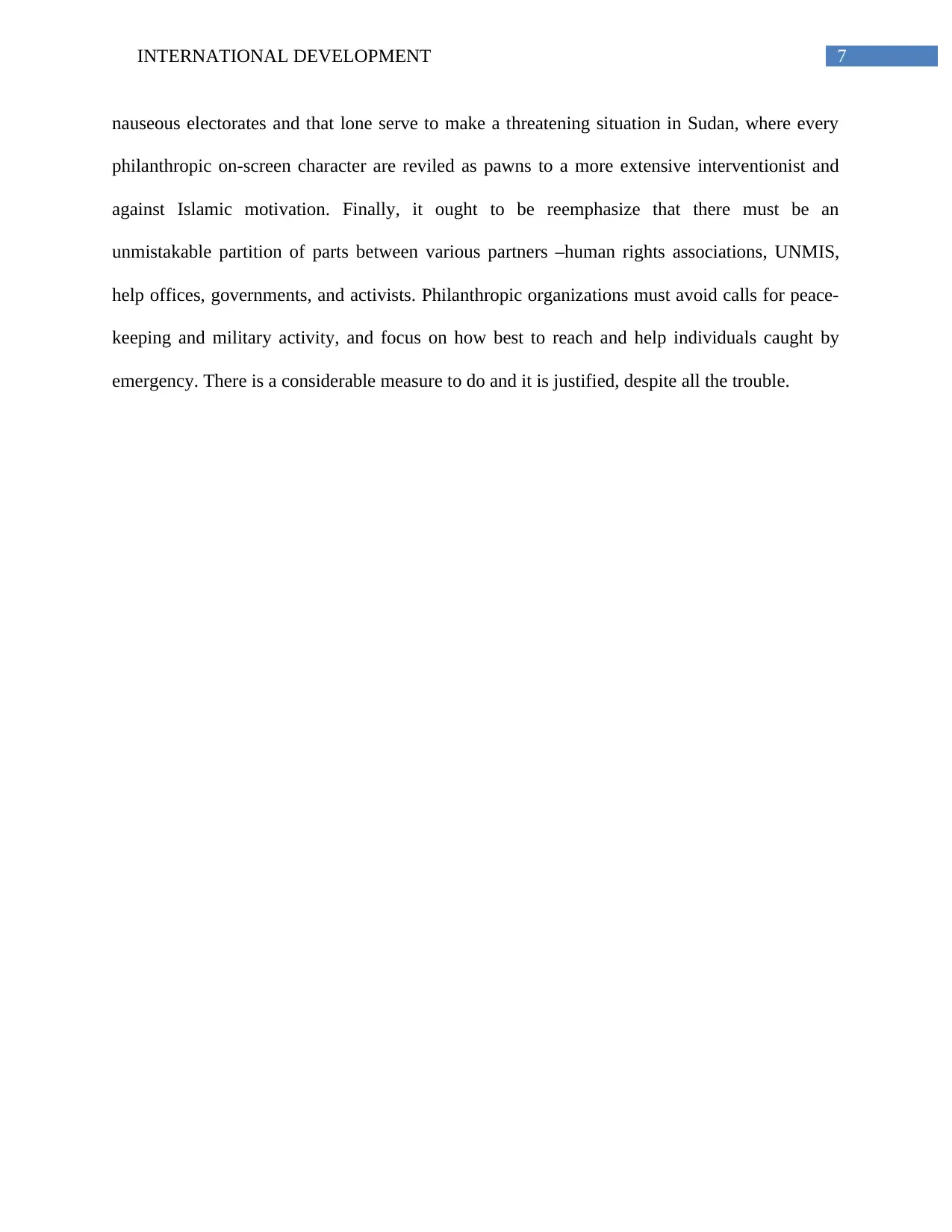
7INTERNATIONAL DEVELOPMENT
nauseous electorates and that lone serve to make a threatening situation in Sudan, where every
philanthropic on-screen character are reviled as pawns to a more extensive interventionist and
against Islamic motivation. Finally, it ought to be reemphasize that there must be an
unmistakable partition of parts between various partners –human rights associations, UNMIS,
help offices, governments, and activists. Philanthropic organizations must avoid calls for peace-
keeping and military activity, and focus on how best to reach and help individuals caught by
emergency. There is a considerable measure to do and it is justified, despite all the trouble.
nauseous electorates and that lone serve to make a threatening situation in Sudan, where every
philanthropic on-screen character are reviled as pawns to a more extensive interventionist and
against Islamic motivation. Finally, it ought to be reemphasize that there must be an
unmistakable partition of parts between various partners –human rights associations, UNMIS,
help offices, governments, and activists. Philanthropic organizations must avoid calls for peace-
keeping and military activity, and focus on how best to reach and help individuals caught by
emergency. There is a considerable measure to do and it is justified, despite all the trouble.
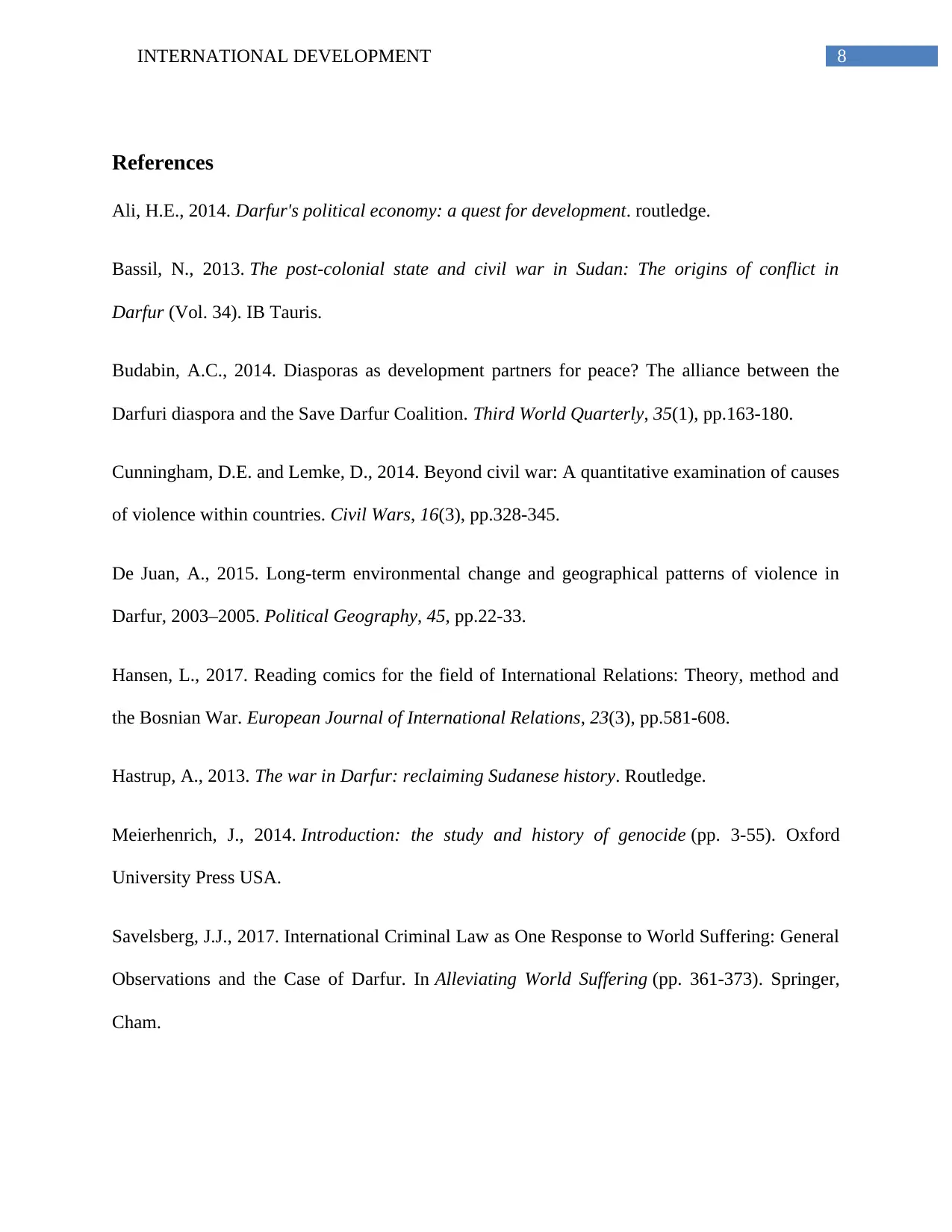
8INTERNATIONAL DEVELOPMENT
References
Ali, H.E., 2014. Darfur's political economy: a quest for development. routledge.
Bassil, N., 2013. The post-colonial state and civil war in Sudan: The origins of conflict in
Darfur (Vol. 34). IB Tauris.
Budabin, A.C., 2014. Diasporas as development partners for peace? The alliance between the
Darfuri diaspora and the Save Darfur Coalition. Third World Quarterly, 35(1), pp.163-180.
Cunningham, D.E. and Lemke, D., 2014. Beyond civil war: A quantitative examination of causes
of violence within countries. Civil Wars, 16(3), pp.328-345.
De Juan, A., 2015. Long-term environmental change and geographical patterns of violence in
Darfur, 2003–2005. Political Geography, 45, pp.22-33.
Hansen, L., 2017. Reading comics for the field of International Relations: Theory, method and
the Bosnian War. European Journal of International Relations, 23(3), pp.581-608.
Hastrup, A., 2013. The war in Darfur: reclaiming Sudanese history. Routledge.
Meierhenrich, J., 2014. Introduction: the study and history of genocide (pp. 3-55). Oxford
University Press USA.
Savelsberg, J.J., 2017. International Criminal Law as One Response to World Suffering: General
Observations and the Case of Darfur. In Alleviating World Suffering (pp. 361-373). Springer,
Cham.
References
Ali, H.E., 2014. Darfur's political economy: a quest for development. routledge.
Bassil, N., 2013. The post-colonial state and civil war in Sudan: The origins of conflict in
Darfur (Vol. 34). IB Tauris.
Budabin, A.C., 2014. Diasporas as development partners for peace? The alliance between the
Darfuri diaspora and the Save Darfur Coalition. Third World Quarterly, 35(1), pp.163-180.
Cunningham, D.E. and Lemke, D., 2014. Beyond civil war: A quantitative examination of causes
of violence within countries. Civil Wars, 16(3), pp.328-345.
De Juan, A., 2015. Long-term environmental change and geographical patterns of violence in
Darfur, 2003–2005. Political Geography, 45, pp.22-33.
Hansen, L., 2017. Reading comics for the field of International Relations: Theory, method and
the Bosnian War. European Journal of International Relations, 23(3), pp.581-608.
Hastrup, A., 2013. The war in Darfur: reclaiming Sudanese history. Routledge.
Meierhenrich, J., 2014. Introduction: the study and history of genocide (pp. 3-55). Oxford
University Press USA.
Savelsberg, J.J., 2017. International Criminal Law as One Response to World Suffering: General
Observations and the Case of Darfur. In Alleviating World Suffering (pp. 361-373). Springer,
Cham.
⊘ This is a preview!⊘
Do you want full access?
Subscribe today to unlock all pages.

Trusted by 1+ million students worldwide
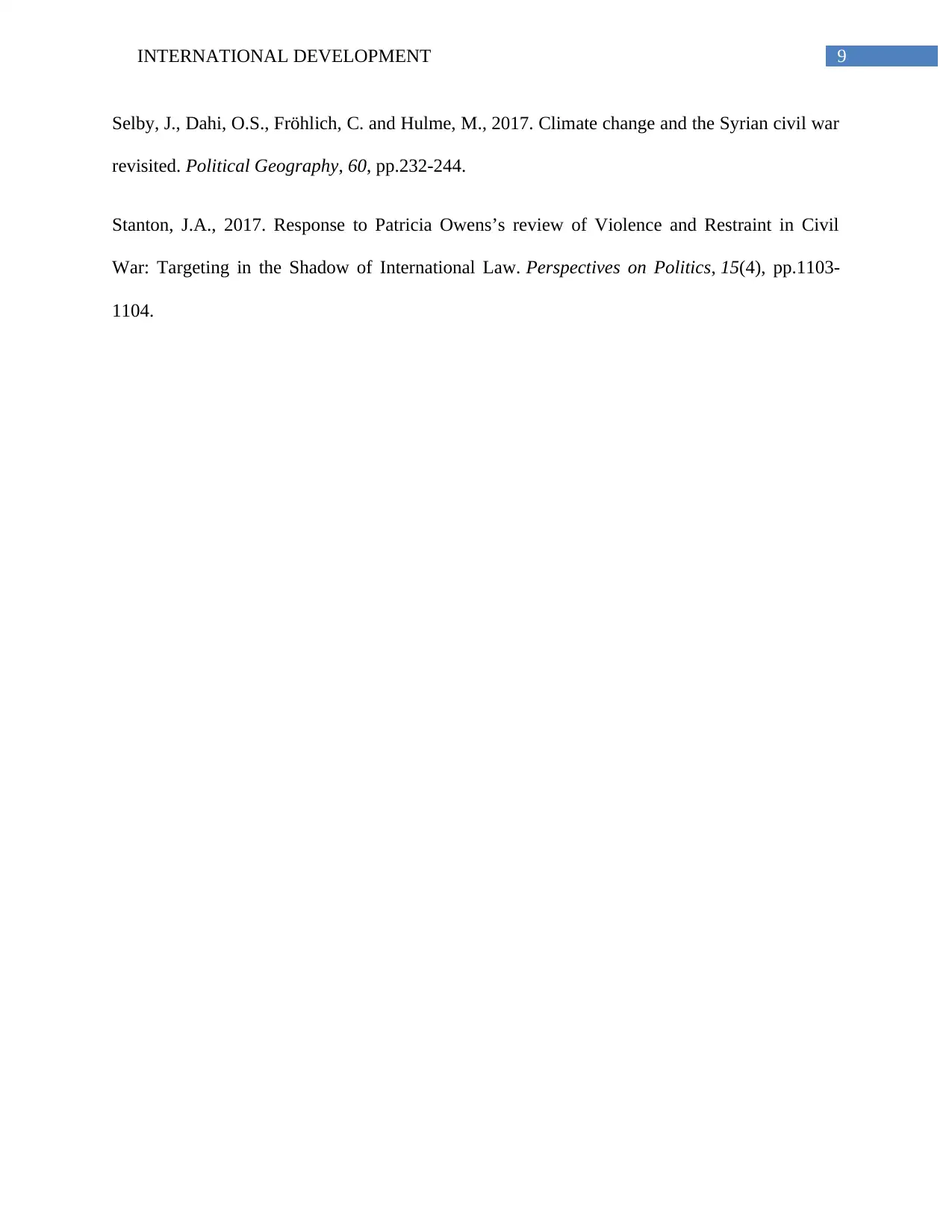
9INTERNATIONAL DEVELOPMENT
Selby, J., Dahi, O.S., Fröhlich, C. and Hulme, M., 2017. Climate change and the Syrian civil war
revisited. Political Geography, 60, pp.232-244.
Stanton, J.A., 2017. Response to Patricia Owens’s review of Violence and Restraint in Civil
War: Targeting in the Shadow of International Law. Perspectives on Politics, 15(4), pp.1103-
1104.
Selby, J., Dahi, O.S., Fröhlich, C. and Hulme, M., 2017. Climate change and the Syrian civil war
revisited. Political Geography, 60, pp.232-244.
Stanton, J.A., 2017. Response to Patricia Owens’s review of Violence and Restraint in Civil
War: Targeting in the Shadow of International Law. Perspectives on Politics, 15(4), pp.1103-
1104.
Paraphrase This Document
Need a fresh take? Get an instant paraphrase of this document with our AI Paraphraser
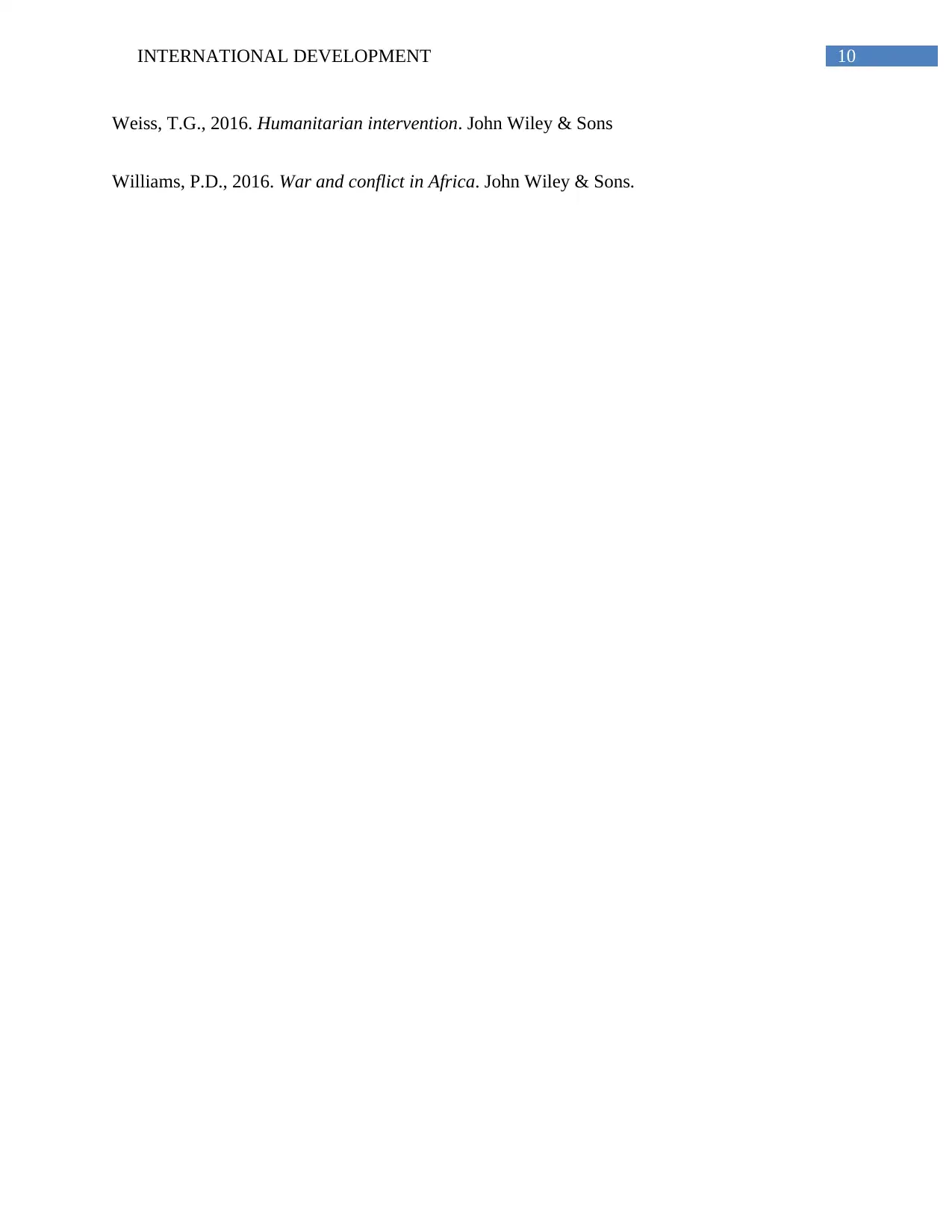
10INTERNATIONAL DEVELOPMENT
Weiss, T.G., 2016. Humanitarian intervention. John Wiley & Sons
Williams, P.D., 2016. War and conflict in Africa. John Wiley & Sons.
Weiss, T.G., 2016. Humanitarian intervention. John Wiley & Sons
Williams, P.D., 2016. War and conflict in Africa. John Wiley & Sons.
1 out of 11
Your All-in-One AI-Powered Toolkit for Academic Success.
+13062052269
info@desklib.com
Available 24*7 on WhatsApp / Email
![[object Object]](/_next/static/media/star-bottom.7253800d.svg)
Unlock your academic potential
Copyright © 2020–2025 A2Z Services. All Rights Reserved. Developed and managed by ZUCOL.

